tow AUDI A6 2014 Owners Manual
[x] Cancel search | Manufacturer: AUDI, Model Year: 2014, Model line: A6, Model: AUDI A6 2014Pages: 304, PDF Size: 76.32 MB
Page 5 of 304
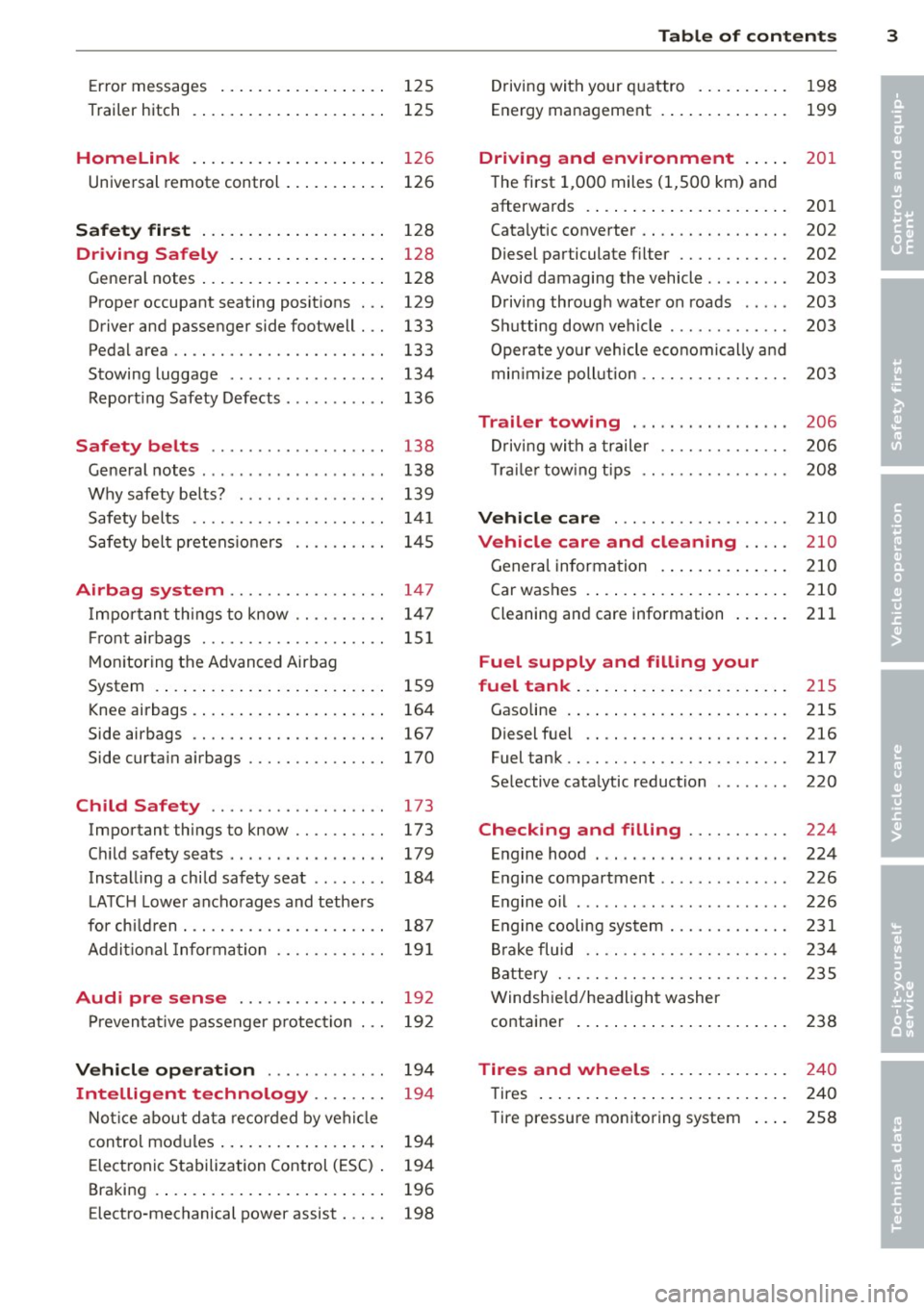
Error messages . . . . . . . . . . . . . . . . . . 125
Trailer hitch . . . . . . . . . . . . . . . . . . . . . 125
Homelink
Universal remote control ... .. .. .. . .
S afet y fir st ... ...... ... .. .. .. . .
Dri ving Safely ...... ... .. .. .. . .
Gene ral notes ..... .... ... .. .. .. . .
Proper occupant seating posit ions . . .
Driver and passenger side footwell . . .
Pedal area .. ................. .. . .
Stowing luggage ............. ... .
Report ing Safety Defects .......... . 126
126
12
8
128
128
129
133
133
1 34
136
Safety belts . . . . . . . . . . . . . . . . . . . 138
Ge neral notes . . . . . . . . . . . . . . . . . . . . 138
Why safety be lts? . . . . . . . . . . . . . . . . 139
Safety belts . . . . . . . . . . . . . . . . . . . . . 1 41
Safety bel t pre tens io ners . . . . . . . . . . 1 45
Airbag system ........... .. .. .. 147
I mpo rtant th ings to know . . . . . . . . . . 147
Fr ont airbags . . . . . . . . . . . . . . . . . . . . 1 51
M on itoring the Advanced Airbag
System . . . . . . . . . . . . . . . . . . . . . . . . . 159
Knee airbags . . . . . . . . . . . . . . . . . . . . . 164
Side airbags . . . . . . . . . . . . . . . . . . . . . 167
Side curta in a irbags . . . . . . . . . . . . . . . 170
Child Safety ............... .. . .
Important things to know .. .. .. .. . .
C hi ld safety seats ... ...... .... .. . .
Install ing a child safety seat .. .. .. . .
L ATC H Lower ancho rages and tethe rs
for ch ild ren . ............. .... .. . .
Addit ional Information
Audi pre sense ..... ... .. .. .. . .
P reven tat ive passenger p rotection
Vehicle operat ion ..... .. .. .. . .
Intelligent technology .. .. .. . .
Not ice about da ta re cor ded by veh icle
control mod ules ... .... ... .. .. .. . .
Elect ronic Stabilization Control (ESC) .
Braking .... .. .... .. .... ... .. .. . .
E lectro-mechanical power assist . .. . . 173
173
179
184
187
19
1
192
19 2
194
194
194
194
196
198
Table of contents 3
Driving with your q uattro . . . . . . . . . . 198
Energy management . . . . . . . . . . . . . . 199
Driving and environment . . . . . 201
The first 1,000 miles (1,500 km) and
afterwards . . . . . . . . . . . . . . . . . . . . . . 201
Catalytic converter . . . . . . . . . . . . . . . . 202
Diesel particulate f ilter . . . . . . . . . . . . 202
Avoid damaging the vehicle . . . . . . . . . 203
Drivi ng throug h wate r on roads . . . . . 203
Sh utting down vehicle . . . . . . . . . . . . . 203
Operate your vehicle economically a nd
min imi ze poll ution . . . . . . . . . . . . . . . . 203
Trailer towing . . . . . . . . . . . . . . . . . 206
Drivi ng with a trailer . . . . . . . . . . . . . . 206
T rail er tow ing t ips . . . . . . . . . . . . . . . . 208
Vehicle care . . . . . . . . . . . . . . . . . . . 210
Vehicle care and cleaning . . . . . 210
Genera l informa tion . . . . . . . . . . . . . . 210
Car was hes . . . . . . . . . . . . . . . . . . . . . . 210
Cleaning and care information . . . . . . 211
Fuel supply and filling your
fuel tank ... .... .. . .. .. ..... ... .
215
Gasoline . . . . . . . . . . . . . . . . . . . . . . . . 215
Diesel f uel . . . . . . . . . . . . . . . . . . . . . . 216
Fuel tank.. .. .. .. ... ............ . 217
Se lective cata lytic reduction . . . . . . . . 220
Checking and filling . . . . . . . . . . . 224
E n gine hood . . . . . . . . . . . . . . . . . . . . . 224
E n gine compartment . . . . . . . . . . . . . . 226
Engine oil . . . . . . . . . . . . . . . . . . . . . . . 226
En gine cooling system . . . . . . . . . . . . . 231
Br ake fluid . . . . . . . . . . . . . . . . . . . . . . 234
B attery . . . . . . . . . . . . . . . . . . . . . . . . . 235
Windsh ie ld/headligh t washer
container . . . . . . . . . . . . . . . . . . . . . . . 238
Tires and wheels . . . . . . . . . . . . . . 24 0
Tires . . . . . . . . . . . . . . . . . . . . . . . . . . . 240
Tire pressure monitoring system . . . . 258
•
•
Page 6 of 304
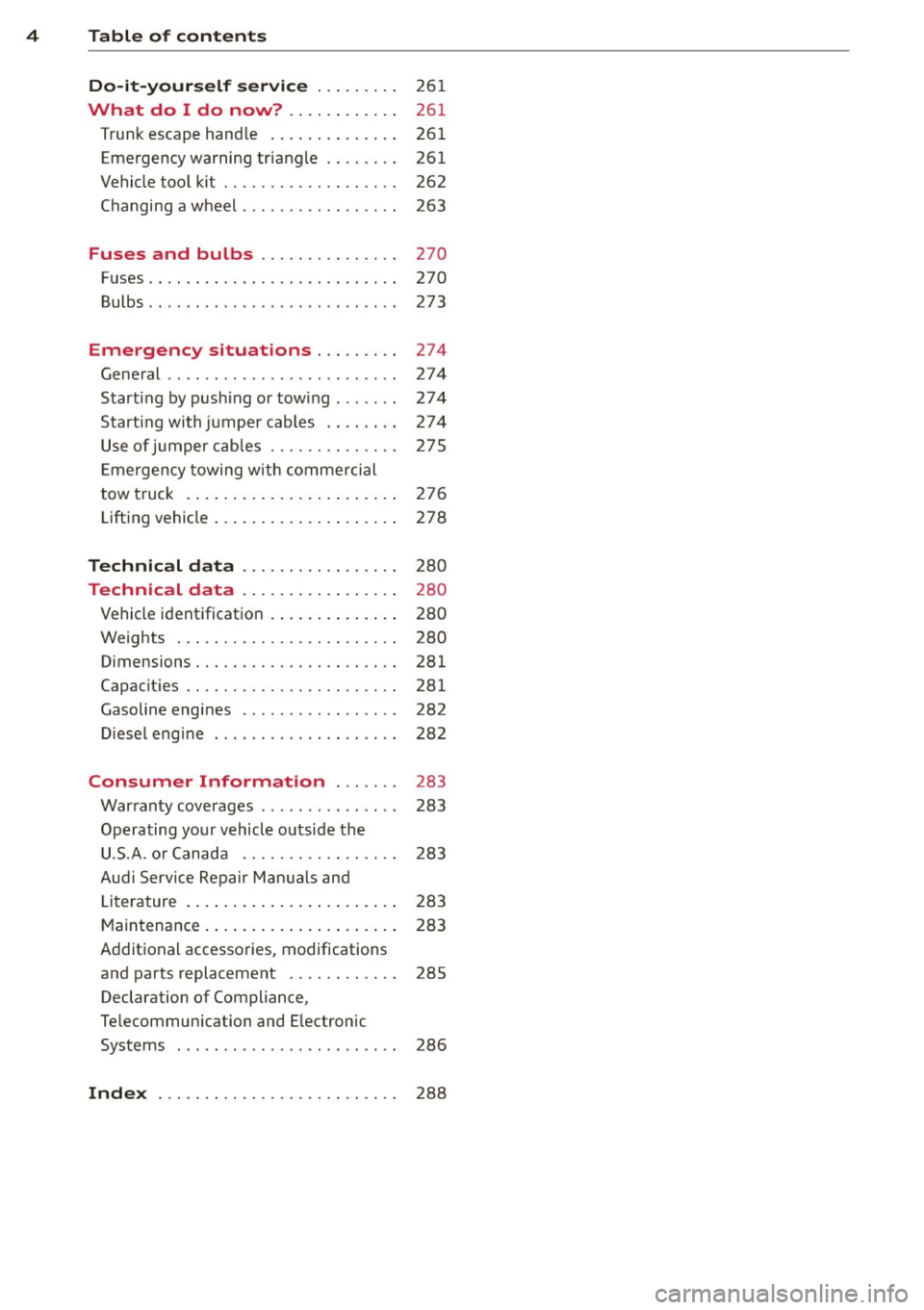
4 Table of contents
Do-it-yourself ser vice . . . . . . . . .
26 1
What do I do now? . . . . . . . . . . . . 261
Trunk escape hand le . . . . . . . . . . . . . . 261
Emergency warning triangle . . . . . . . . 261
Vehicle too l kit . . . . . . . . . . . . . . . . . . . 262
Changing a wheel . . . . . . . . . . . . . . . . . 263
Fuses and bulbs . . . . . . . . . . . . . . . 270
Fuses . . . . . . . . . . . . . . . . . . . . . . . . . . . 270
Bulbs .. .. .. ... .... .... .. .. .. .. .. 273
Emergency situations ... .. .... 274
General . . . . . . . . . . . . . . . . . . . . . . . . . 274
Start ing by push ing or tow ing . . . . . . . 274
Startingwith jumpe rcables .. .. .... 274
Use of jumper cab les . . . . . . . . . . . . . . 275
E mergency towing with comme rcial
tow truck . . . . . . . . . . . . . . . . . . . . . . . 276
Lifting vehicle . . . . . . . . . . . . . . . . . . . . 278
Technical data . . . . . . . . . . . . . . . . . 280
Technical data . . . . . . . . . . . . . . . . . 280
Vehicle identification . . . . . . . . . . . . . . 280
Weights . . . . . . . . . . . . . . . . . . . . . . . . 280
D imensions. . . . . . . . . . . . . . . . . . . . . . 281
Capacities . . . . . . . . . . . . . . . . . . . . . . . 281
Gasoline engines . . . . . . . . . . . . . . . . . 282
Di esel eng ine . . . . . . . . . . . . . . . . . . . . 282
Consumer Information . . . . . . . 283
Warranty coverages . . . . . . . . . . . . . . . 283
Operating your vehicle outside the U.S.A . o r Canada . . . . . . . . . . . . . . . . . 283
Audi Service Repair M anuals and
Li terature . . . . . . . . . . . . . . . . . . . . . . . 283
M aintenance . . . . . . . . . . . . . . . . . . . . . 283
Additional accessories, modifications
and parts replacement . . . . . . . . . . . . 285
Declaration of Compliance,
Telecommunication and E lectronic
Systems . . . . . . . . . . . . . . . . . . . . . . . . 286
Inde x . . . . . . . . . . . . . . . . . . . . . . . . . . 288
Page 20 of 304
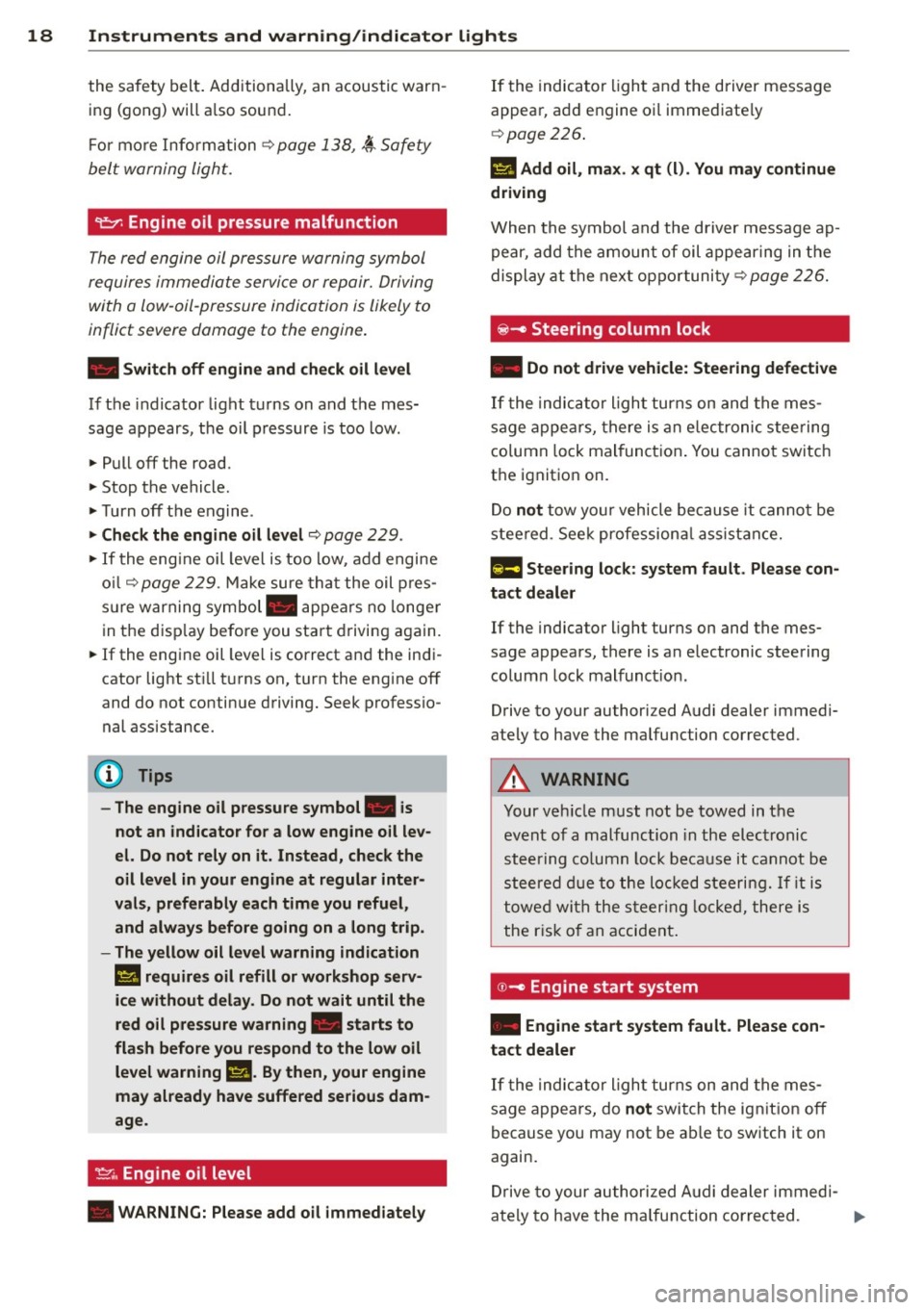
18 Instrum ent s and w arn ing /indic ato r light s
the safety belt. Additionally, an acoustic warn
ing (gong) will a lso sound.
For more Information
c::> page 138, ~ Safety
belt warning light.
requires immediate service or repair. Driving
with a low-oil-pr essur e indication is likely to
inflict severe damage to the engine.
• Swit ch off engine and ch ec k oil l evel
If the indicator light turns on and the mes
sage appears, the oil pressure is too low .
., Pull off the road.
., Stop the vehicle.
., Turn off the engine .
., Check the engin e oil level c::> page 229 .
., If the engine oil level is too low, add engine
oil
c::> page 229 . Make sure that the oil p res
s u re warning symbol. appears no longe r
in the disp lay before you start dr iving again.
• If the engine oil level is correct and the indi
cato r light sti ll turns on, turn the engine off
and do not continue driving. Seek professio
nal assistance.
(D Tips
- The engine oil pressu re symbol. is
not an indicator for a low eng ine oil lev
el. Do not rel y on it. Inst ead , che ck th e
oil l evel in your engin e at regular int er
val s, pref erabl y each tim e you refu el,
and alwa ys bef ore go ing on a long trip .
- The yell ow oil le vel warning indication
II requires oil refill or wo rksho p serv ·
ic e without del ay . Do n ot wait unti l the
red oil pre ssur e w arning. sta rt s to
fla sh before you re spond t o the low oil
le vel warning
II. By then , your engine
may al ready have suffered serious dam
age .
~ .. Engine oil level
• WARNING: P lease add oil immedia tely
If the indicator light and the driver message
appear, add engine oi l immediate ly
c::> page 226 .
II Add oil, m ax. x q t (l). Yo u m ay contin ue
driving
When the symbol and the driver message ap
pear, add the amount of oil appearing in the
display at the nex t oppor tunity
c::> page 226.
@ -Steering column lock
• Do not dr ive veh icle : Stee ring defecti ve
If the indicator l igh t turns on and the mes
sage appears, there is an e lectronic stee ring
column lock malfunction . You cannot switch
the ignition on .
Do
not tow your vehicle because it cannot be
steered . See k professiona l assistance .
1;11 Steering lo ck : s ystem fault . Plea se con
tact de ale r
If the indica tor light turns on and the mes
sage appears, there is an electronic steering
column lock malfunct io n.
Drive to your authori zed Audi dealer immedi
ately to have the mal function corrected .
A WARNING
Your vehicle must not be towed in the
event of a malfunction in the electronic
steering co lumn lock because it cannot be
steered due to the loc ked steering. If it is
towed with the steering locked, there is
the r isk o f an accident .
©-Engine start system
• Engine st art system fa ult. Ple ase con
tact deale r
If the indicator l ight turns on and the mes
sage appears, do
n ot switch the ignition off
because you may not be ab le to switch it on
again.
Drive to your authorized A udi dealer immed i-
a tely to have the ma lfunction corrected. ..,.
Page 26 of 304
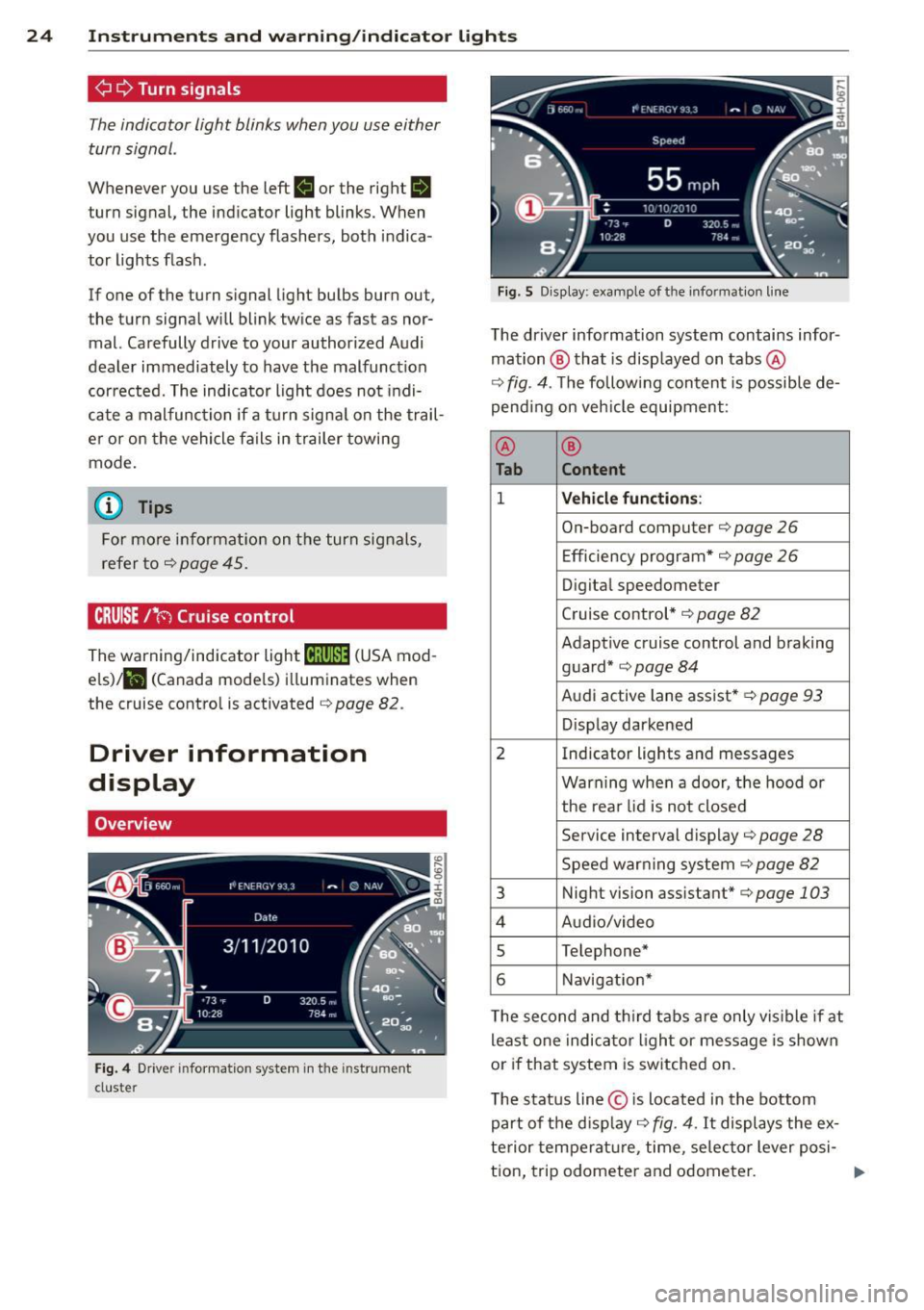
24 Instr uments and warning/indicator lights
¢¢Turn signals
The indicator light blinks when you use either
turn signal .
Whenever you use the left II or the rig ht a
turn signal, the indicator light blinks. When
you use the emergency flashers, both indica
tor lights flash.
If one of the turn signal light bulbs burn out,
the turn signal will blink twice as fast as nor
mal. Carefully drive to your authorized Audi
dealer immediately to have the malfunction
corrected. The indicator light does not indi
cate a malfunction if a turn signal on the trail
er or on the vehicle fails in trailer towing
mode.
@ Tips
For more informat ion on the turn signals,
refer to
c::> page 45.
CRUISE/" (') Cruise control
The warning/indicator light (ij;(l)~i~ (USA mod
e ls)/ il (Canada mode ls) illuminates when
the cruise contro l is activated
c::> page 82.
Driver information
display
Overview
Fig. 4 Driver information system in the instrument
cluster
Fig. 5 Disp lay: example of the informat ion line
The driver information system contains infor
mation ® that is disp layed on tabs@
c::> fig. 4. The following content is possible de
pending on veh icle equipment:
@ ®
Tab Content
1 Vehicle functions :
On-board computer c::> page 26
Efficiency program*
c::> page 26
Digital speedometer
Cruise control*
c::> page 82
Adaptive c ruise control and braking
guard*
c::> page 84
Audi active lane assist* c::> page 93
Display darkened
2 Indicator lights and messages
Warning when a door, the hood or
the rea r lid is not closed
Service interval display
c::> page 28
Speed warning system c::> page 82
3 Night vision assistant* c::> page 103
4 Audio/video
s Telephone*
6 Navigation*
The second and third tabs a re only vis ible if at
least one indicator lig ht or message is shown
or if that system is switched on.
T he status line © is located in the bottom
part of the display
c::> fig. 4. It displays the ex
terior temperature , time, se lector lever posi-
tion, trip odometer and odometer. ..,.
Page 28 of 304
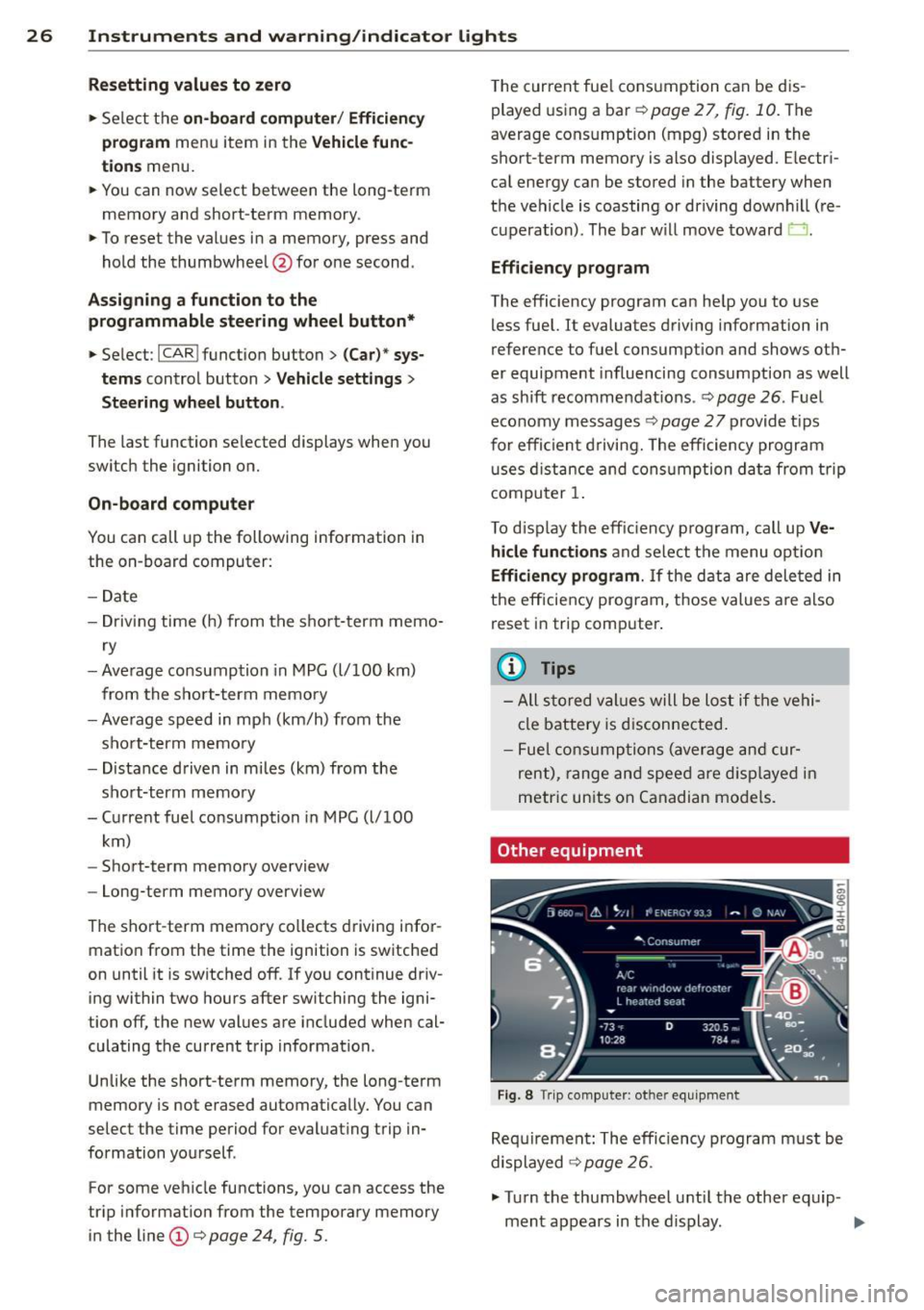
26 Instruments and warning /indicator lights
Resetting values to zero
.,. Se lect t he on -board computer / Efficien cy
program
men u item in the Vehicle func
tions
menu.
.,. You can now select between the long-term
memory and short -term memory .
.,. To reset the values i n a memory, press and
ho ld the thumbwhee l@ for one second .
Assigning a function to the
programmable steering wheel button*
.,. Se lect : ICAR !funct io n button> (Car )* sys-
tems
control button > Vehicle settings >
Ste ering wh eel button .
The last function se lected displays when y ou
switch the ignition on.
On-board computer
You can call up the following information in the on -board computer:
- D ate
- Drivi ng time ( h) from t he s ho rt- term memo-
ry
- Ave rag e consumption in MPG (l/ 100 km)
from the sho rt-term memo ry
- Ave rag e speed in mph (km/h) from the
s h ort-term memo ry
- Distance d riven in m iles (km) from the
sho rt-term me mory
- C urrent fuel co nsumption in MPG (l/100
k m)
- Sho rt-term memo ry overview
- Long-term memory overview
The s ho rt-term memo ry co llects driving i nfo r
mat io n from the time the ignit ion is switched
on until it is switched off. If yo u continue dr iv
ing within two hours after switching the igni
tion off, the new val ues a re i ncluded when cal
culating the cu rrent trip informa tion .
Unlike the short-term memory, the long-term
memory is not erased automatica lly. You can
select the time period for evaluat ing trip in
formation yo urse lf.
For some veh icle functions, you can access the
tr ip i nformat io n from the tempora ry memory
i n the line
(D ¢ page 24 , fig. 5.
The current fue l cons umption can be d is
played using a ba r
¢page 27, fig . 10. The
average cons umption (mpg) stored in the
short-term memo ry is also displayed. E lectri
ca l energy can be sto red in the battery when
t h e vehicle is coasting or dr iving dow nhill (re
c u pera tion) . The bar w ill move toward
Cl .
Efficiency program
The efficiency program can he lp y ou to use
less fuel.
It evaluates driving information in
reference to f uel consumption and shows ot h
er equipment influencing consumption as well
as shift recomme ndat ions .
¢ page 26. Fu el
eco nomy m essages
<=:> page 2 7 provide t ips
f o r efficient d riving. The effi ciency program
u ses d ist ance and cons umpti on d ata from trip
c om puter
1.
T o d is pl ay th e eff ic ien cy p rogram, call up Ve
hicle functions
and se le ct t he menu o ptio n
Efficiency program. If the d ata are dele ted in
t h e eff icien cy prog ram, th ose values a re a lso
reset in tri p com puter .
@ Tips
-All s tored v alu e s will be los t if th e ve hi
cl e battery is dis con nected .
- Fue l consum ptio ns (a ver age an d cu r
ren t), range an d s pee d ar e disp laye d in
metric un its on Canadian mode ls.
Other equipment
Fi g. 8 Tri p comp uter: ot her equi pm en t
Req uire ment: T he e fficiency p rogram m ust be
displayed
<=:> page 26 .
.,. Turn the thumbwheel u ntil the other eq uip-
ment appears in the d isplay . .,.
Page 46 of 304
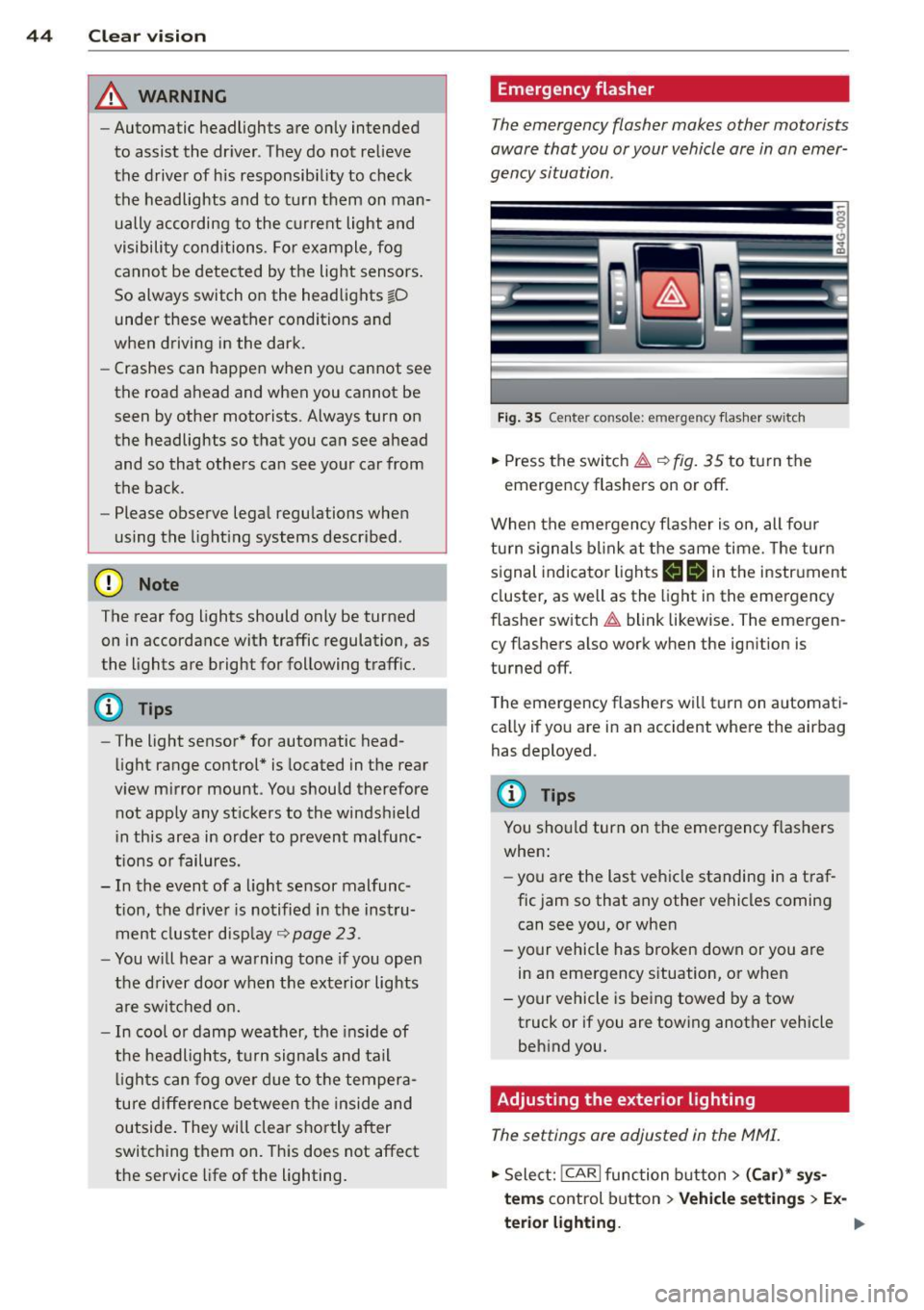
44 Clear vision
& WARNING
-Automatic headlights are only intended
to assist the driver . They do not relieve
the driver of his responsibility to check
the headlights and to turn them on man
ually according to the current light and
visibility conditions. For example, fog
cannot be detected by the light sensors.
So always switch on the headlights
io
under these weather conditions and
when driving in the dark.
- Crashes can happen when you cannot see
the road ahead and when you cannot be
seen by other motorists. Always turn on
theheadlightssothatyoucanseeahead and so that others can see your car from
the back .
- Please observe legal regulations when
using the lighting systems described .
(D Note
The rear fog lights should only be turned
on in accordance with traffic regulation, as
the lights are bright for following traffic.
{D) Tips
- The light sensor* for automatic head
light range control* is located in the rear
view mirror mount . You should therefore
not apply any stickers to the windshield
in this area in order to prevent malfunc
tions or failures .
- In the event of a light sensor malfunc
tion, the driver is notified in the instru
ment cluster display ~
page 23 .
-You will hear a warning tone if you open
the driver door when the exterior lights
are switched on.
- In cool or damp weather, the inside of
the headlights, turn signals and tail lights can fog over due to the tempera
ture difference between the inside and
outside. They will clear shortly after
switching them on. This does not affect
the service life of the lighting.
Emergency flasher
The emergency flasher makes other motorists
aware that you or your vehicle are in an emer
gency situation .
Fig. 35 Ce nte r co nso le: em erg en cy flash er sw itc h
.. Press the switch~~ fig. 35 to turn the
emergency flashers on or off.
When the emergency flasher is on, all four
turn signals blink at the same time. The turn
signal indicator lights
B Nin the instrument
cluster, as well as the light in the emergency
flasher switch
~ blink likewise. The emergen
cy flashers also work when the ignition is
turned off.
The emergency flashers will turn on automati
cally if you are in an accident where the airbag
has deployed.
@ Tips
You should turn on the emergency flashers
when:
- you are the last vehicle standing in a traf
fic jam so that any other vehicles coming
can see you, or when
- your vehicle has broken down or you are
in an emergency situation, or when
-your vehicle is being towed by a tow
truck or if you are towing another vehicle
behind you.
Adjusting the exterior lighting
The settings ore adjusted in the MMI.
.. Select: !CARI function button> (Car)* sys
tems
control button > Vehicle settings > Ex-
terior lighting.
Ill>
Page 47 of 304
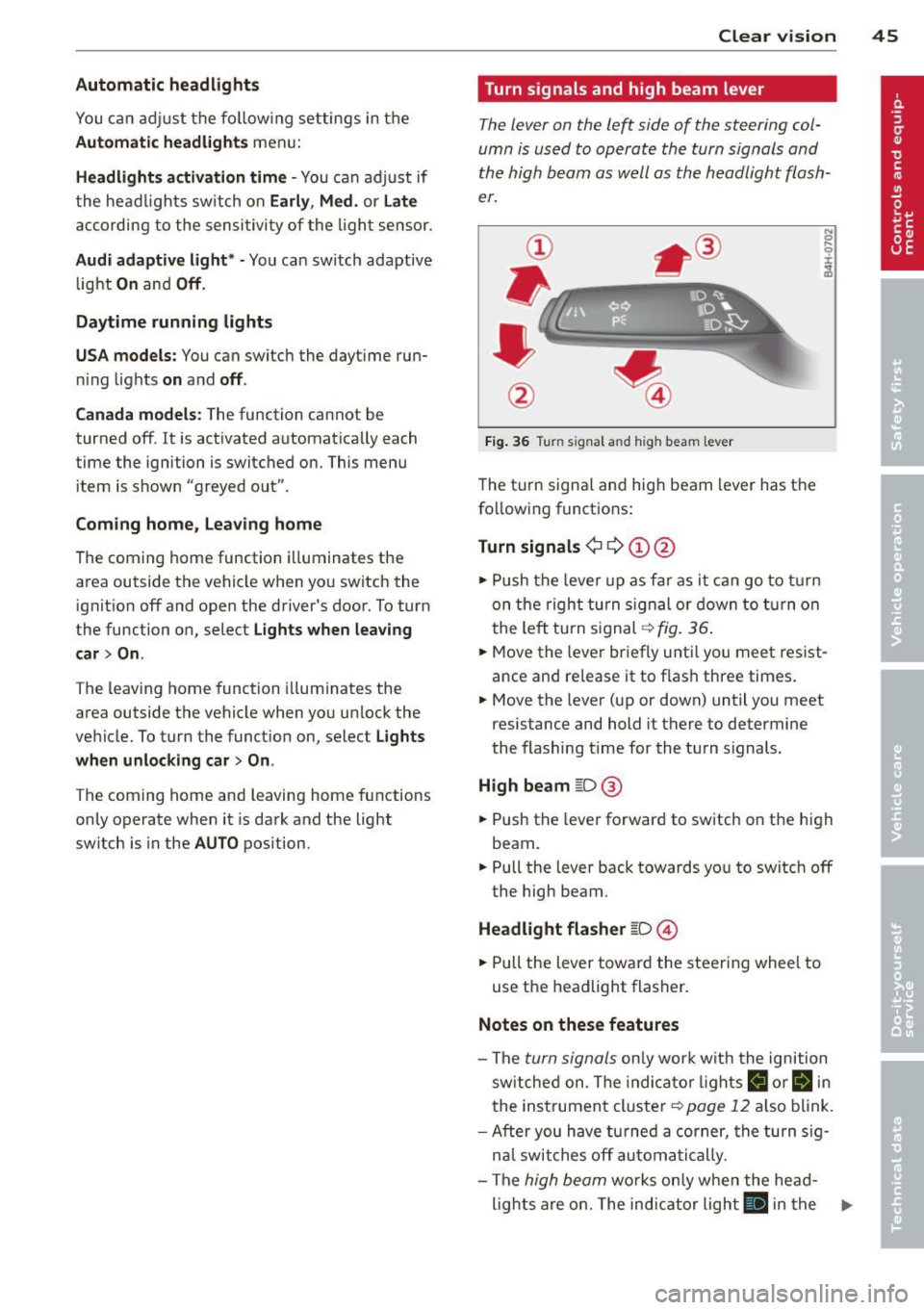
Automatic headlights
You can adjust the following settings in the
Automatic headlights menu:
Headlights activation time -You can adjust if
the headlights switch on
Early, Med . or Late
according to the sensitivity of the ligh t sensor.
Audi adaptive light* -You can switch adaptive
light
On and Off.
Daytime running lights
USA models:
You can switch the dayt ime run
n ing lights
on and off .
Canada models :
The function cannot be
turned off . It is activated automatically each
time the ignition is switched on. This menu
item is shown "greyed out" .
Coming home, Leaving home
The coming home function illuminates the
area outside the vehicle when you switch the
ignition off and open the driver's door. To turn
the function on, select
Lights when leaving
car > On .
The leaving home function illuminates the
area outside the vehicle when you un lock the
vehicle. To turn the funct ion on, select
Lights
when unlocking car > On .
The coming home and leaving home functions
only operate when it is dark and the light
switch is in the
AUTO position. Clear
vision 45
Turn signals and high beam lever
The lever on the left side of the steering col
umn is used to operate the turn signals and
the high beam as well as
the headlight flash
er.
Fig. 36 Tu rn signal and high beam lever
The turn signal and high beam lever has the
following functions:
Turn signals ¢ 9 ©@
.,. Push the lever up as fa r as it can go to turn
on the right turn signa l or down to turn on
the left tu rn s ignal ¢
fig. 36.
.. 0 ....
~
... Move the lever briefly unti l you meet resist
ance and re lease it to flash three times.
.,. Move the lever (up or down) until you meet
resistance and hold it there to determine
the flashing time for the turn signals.
High beam ~D @
... Push the lever forward to switch on the high
beam .
.,. Pull the lever back towards you to switch off
the high beam.
Headlight flasher ~D ©
... Pull the lever toward the steering wheel to
use the headlight flasher.
Notes on these features
-The turn signals on ly work w ith the ignition
sw itched on. The indicator l ights
B or Bin
the instrument cluster¢ page 12 also blink.
-After you have turned a corner, the turn sig-
n al switches off automatically.
- The
high beam works only when the head-
lights are on. The indicator light
El in the .,.
Page 48 of 304
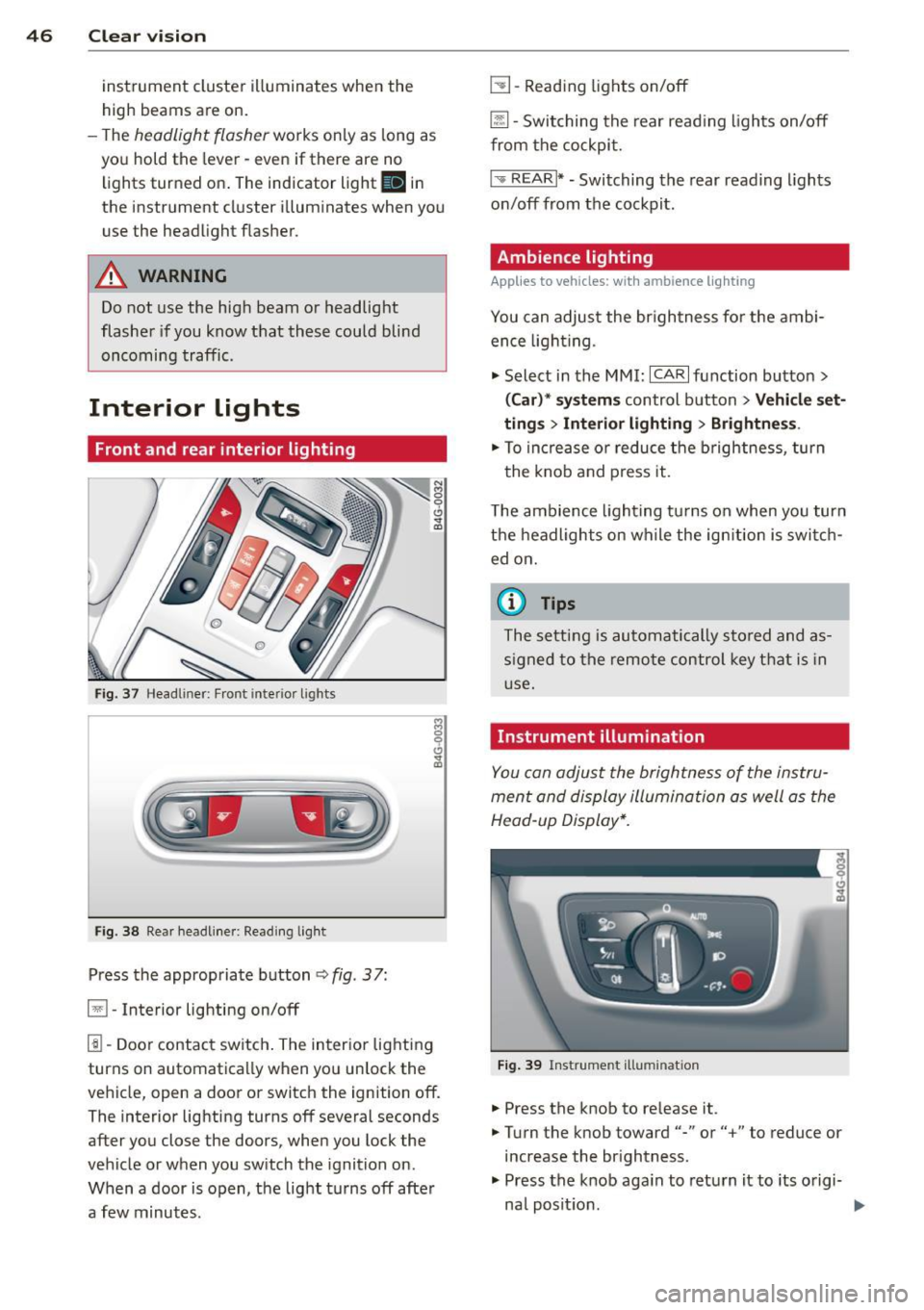
46 Clear vis ion
instrument cluste r illuminates when the
high beams are on.
- T he
headlight flash er works only as long as
yo u hold the lever - even if there are no
l ights turned on. The indicator light
II in
the instrument cluster il luminates when you
use the headlight flasher.
A WARNING
Do not use the high beam or headlight
flasher if you know that these could blind
oncoming traffic.
Interior lights
Front and rear interior lighting
Fi g. 37 Headliner: Front interior ligh ts
Fig . 38 Re ar headli ne r: Readi ng light
Press the appropriate button q fig . 3 7:
El -Interior lighting on/off
I]]-Door contac t sw itch . The inter ior lighting
turns on automatica lly when you unlock the
vehicle, open a door or switch the ignition off.
The interior lighting turns off several seconds
after you close the doors, when you lock the
vehicle or when you sw itch the ignition on.
When a door is open, the light t urns off afte r
a few minutes.
L:!l -Read ing lights on/off
~ - Switching the rear read ing lights on/off
from the cockpi t.
I" REARI * -Switching the rear reading lights
o n/off from the cockpit.
Ambience lighting
Applies to vehicles: w ith amb ience lighting
You can adjust the br ightness for the ambi
ence ligh tin g.
.. Select in the MMI:
ICA RI function button>
(Car )* sys tem s control button > Vehicle set
ting s
> Interi or lighting > Brightne ss.
.. To increase or reduce the b rightness, turn
t he knob and press it .
T he ambience light ing tu rns on when you turn
the headlights on wh ile the ign ition is swi tc h
ed on.
(D Tips
The setti ng is automati cally sto red and as
s igned to the remo te contr ol key t hat i s in
u se.
Instrument illumination
You can adjust the brightness of the instru
men t and di splay illumination a s well as the
Head-up Display*.
Fi g. 39 Instrume nt illumina tion
... Press the knob to release it.
.. Turn the knob toward"-" or"+" to reduce or
increase the br ightness .
.. Press the knob aga in to return it to its o rigi-
na l posit ion . ...
Page 49 of 304
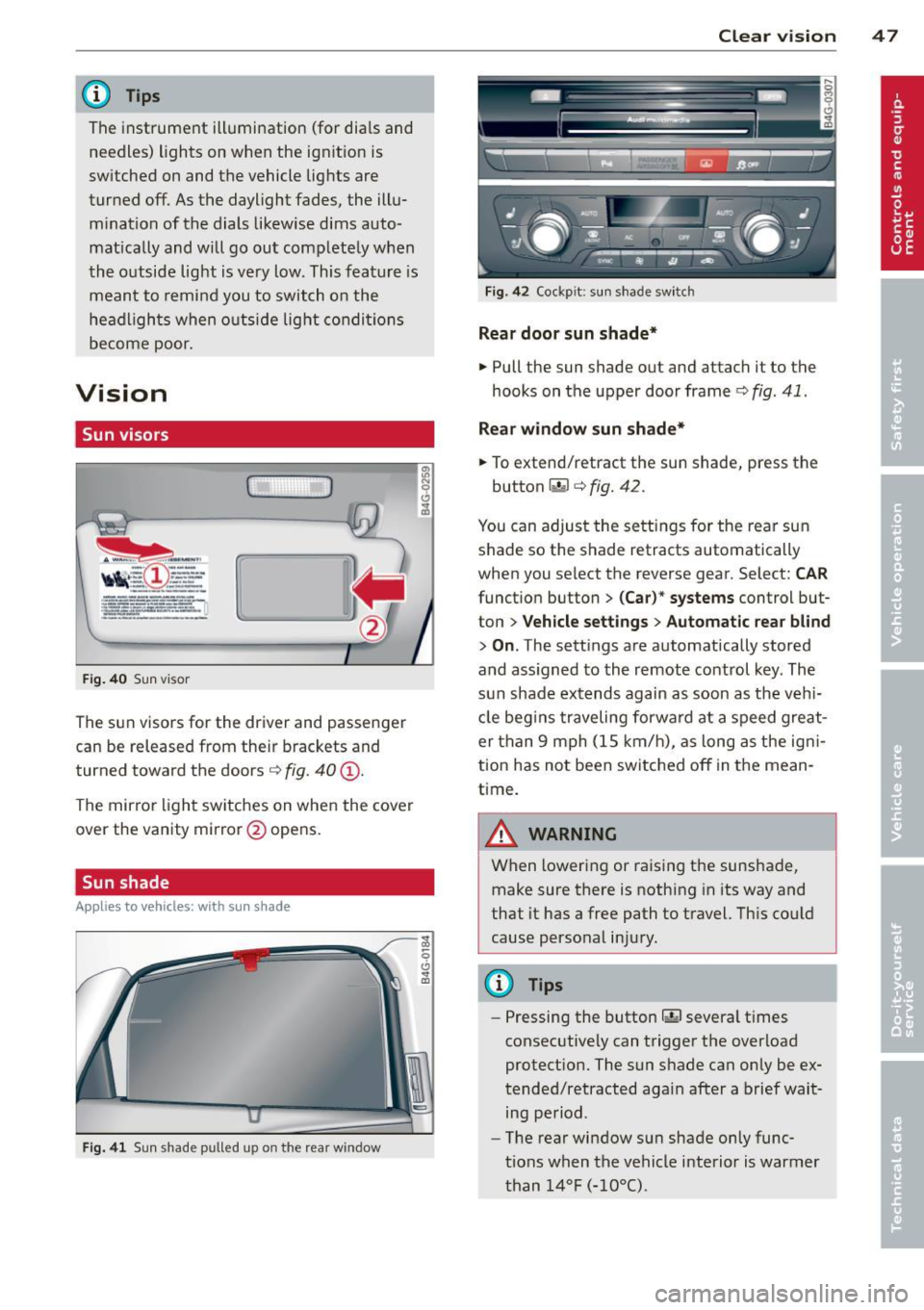
@ Tips
The instrument illumination (for dials and
needles) lights on when the ign it ion is
sw itched on and the vehicle lig hts are
turned off. As the daylight fades, the illu
m ination of the dials likewise dims auto
mat ically and w ill go out comp lete ly when
the o utside lig ht is ve ry low. This fea ture is
meant to remi nd you t o swit ch on the
headl igh ts when o utside light condi tions
become poor.
Vision
Sun visors
( J
F ig . 40 Sun visor
The sun visors for the driver and passenger
can be released from their brackets and
turned toward the doors¢
fig. 40@.
The mirror light switches on when the cover
over the vanity mirror @opens.
Sun shade
Applies to vehicles: with sun shade
F ig . 41 Sun shade pulled up on the rea r window
Clear vi sion 4 7
Fig . 4 2 Cockp it: sun shade switch
Rear door sunshade*
.. Pull the sun shade out and attach it to the
hooks on the upper door frame¢
fig. 41 .
Rear window sun shade*
.. To extend/retract the sun shade, press the
button~ ¢
fig. 42.
You can adjust the settings for the rear sun
shade so the shade retracts automatically
when you select the reverse gear. Select:
CAR
function button > (Car )* systems control but
ton >
V ehicle settings > Automatic rea r bl ind
> On .The sett ings are automatically stored
and ass igned to the remote control key . The
s u n shade extends again as soon as the v ehi
cle beg ins traveling forwa rd at a speed gre at
er than 9 mph (1S km/h), as long as the ig ni
tion has not been switched off in the mean
time.
A WARNING
When lowering or raising the sunshade, make sure there is nothing in its way and
that it has a free path to t ravel. Th is cou ld
cause perso nal inju ry.
@ Tips
-
- Pressing the button rn severa l t imes
consec utive ly can trigger the overload
protect ion. The sun s hade can only be ex
tended/retracted again after a brief wait ing period.
- The rear window sun shade only func
tions when the vehicle i nterior is warmer
than
1 4°F ( -10°() .
Page 65 of 304
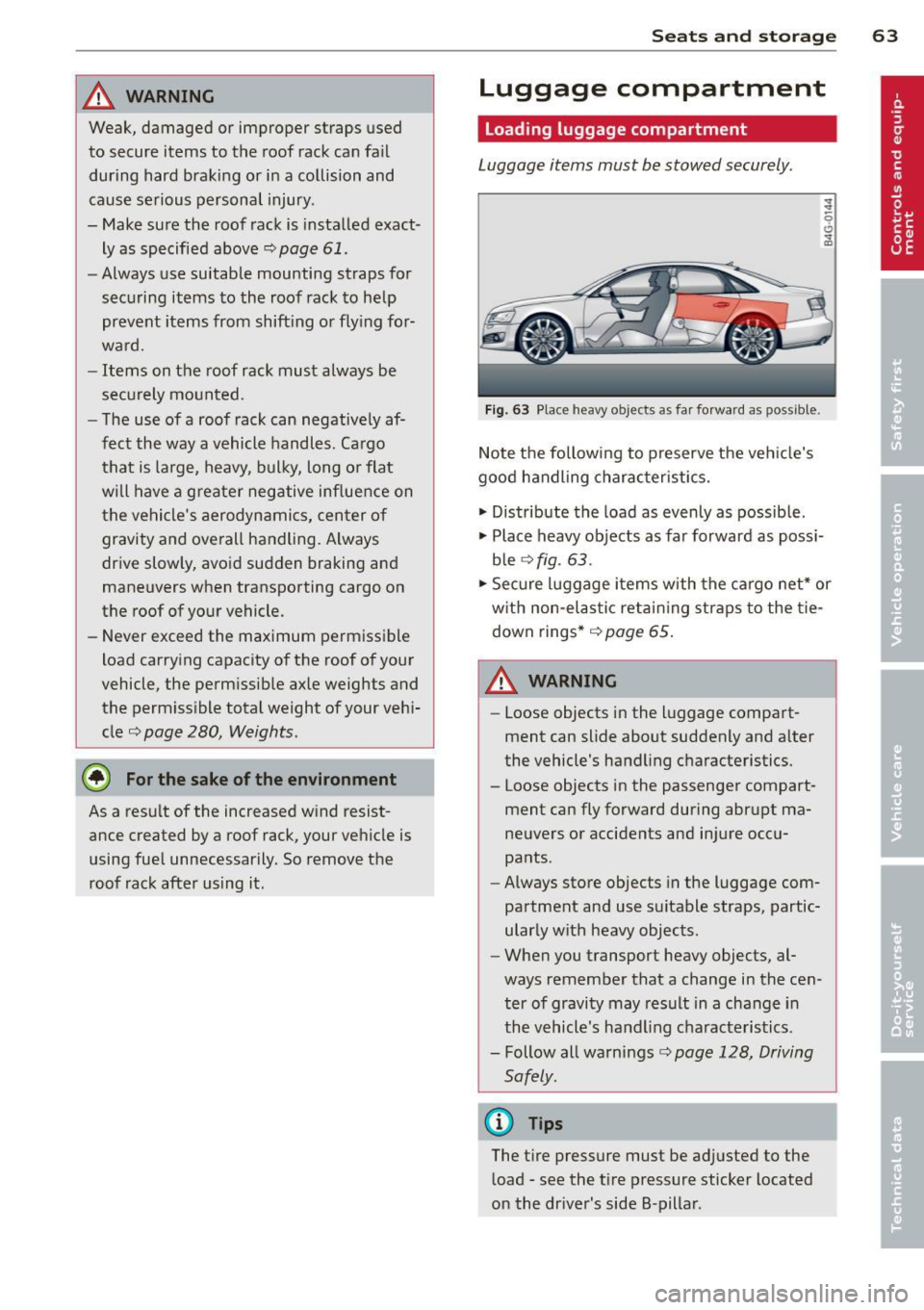
_& WARNING
Weak, damaged or improper straps used
to secure items to the roof rack can fail
during hard braking or in a collision and
cause serious personal injury .
- Make sure the roof rack is installed exact
ly as specified above
c::;, page 61 .
-Always use suitable mounting straps for
securing items to the roof rack to help
prevent items from shift ing or fly ing for
ward.
- Items on the roof rack must always be
securely mounted .
- The use of a roof rack can negatively af
fect the way a vehicle handles . Cargo
that is large, heavy, bulky, long o r flat
will have a greater negative inf luence on
the vehicle 's aerodynamics, center of
gravity and overall handling . Always
drive slowly, avoid sudden braking and
maneuvers when transporting cargo on
the roof of your vehicle.
- Never exceed the maximum permissible
load carrying capacity of the roof of your
vehicle, the perm issible axle weights and
the permiss ible total weight of your vehi
cle
c::;, page 280, Weights .
@ For the sake of the environment
As a result of the increased wind resist
ance created by a roof rack, your veh icle is
using fuel unnecessarily. So remove the
roof rack after using it.
S ea ts a nd s to rage 63
Luggage compartment
Loading luggage compartment
Luggage i tems must be stowed securely.
Fig. 63 P la ce h eavy o bject s as far forward a s possible .
Note the following to preserve the vehicle's
good handling charac teristics.
.., Distribute the load as evenly a s possible.
.., Place heavy objects as far forward as poss i
ble
c::;, f ig . 63 .
.., Secure luggage items with the cargo net* or
w ith non-elastic retain ing straps to the tie
down rings*
c::;, page 65.
A WARNING
- Loose objects in the l uggage compart
ment can slide about suddenly and a lter
the vehicle's handling characteristics.
- Loose objects in the passenger compart
ment can fly forward during abr upt ma
neuvers or accidents and injure occu
pants .
- Always store objects in the luggage com
partment and use suitable straps, partic
ularly with heavy objects .
-
-When you transport heavy objects, al
ways remember that a change in the cen
ter of gravity may result in a change in
the vehicle's handling characteristics.
- Follow all warnings
c::;, page 128, Driving
Safely .
(D Tips
The tire pressure must be ad justed to the
load -see the t ire pressure sticker located
on the dr iver's side B -pillar .